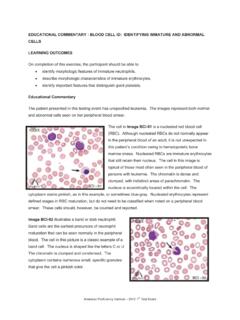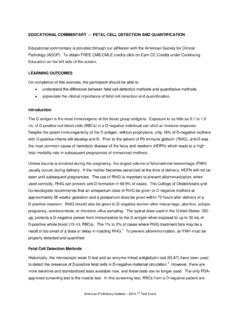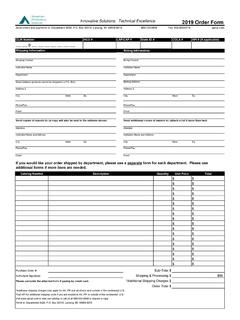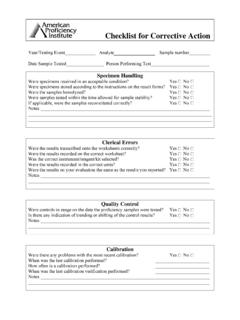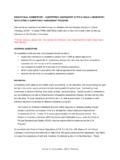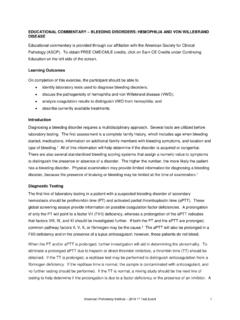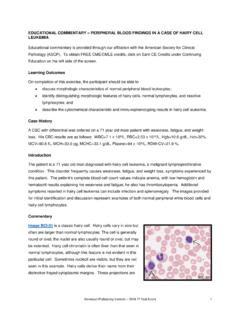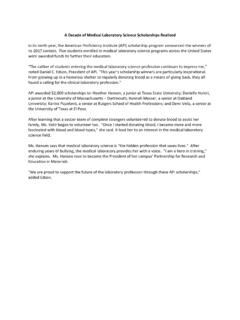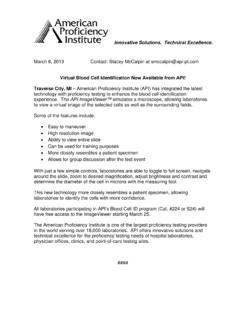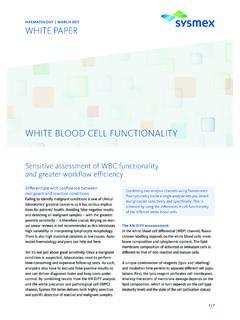Transcription of ADVANCED BLOOD CELL ID: MORPHOLOGIC …
1 American Proficiency Institute 2013 2nd Test Event ADVANCED BLOOD CELL ID: MORPHOLOGIC FEATURES OF blast cells Laboratories performing BLOOD Cell Identification were invited to participate in this pilot study for a new virtual BLOOD cell identification program that includes case studies with more difficult challenges. To view the BLOOD cell images in more detail, click on the sample identification numbers underlined in the paragraphs below. This will open a virtual image of the selected cell and the surrounding fields. If the image opens in the same window as the commentary, saving the commentary PDF and opening it outside your browser will allow you to switch between the commentary and the images more easily. Click on this link for the API ImageViewerTM Instructions.
2 Case Study A 21 year old female was seen in the outpatient bone marrow transplant clinic. Her CBC results are as follows: WBC= x 109/L, Hgb= g/dL, MCV= fL, MCH= pg, MCHC= g/dL, RDW = , Platelet=6 x 109/L. Educational Commentary The patient presented in the case study for this ADVANCED BLOOD Cell Identification testing event was diagnosed with T-cell acute lymphoblastic leukemia (ALL). The images chosen for this educational activity are primarily lymphoblasts that have been selected for review and discussion. Acute lymphoblastic leukemia (ALL) is a malignancy characterized by a proliferation of either B or T lymphoblasts. In T-cell ALL, the neoplastic cells are committed to the T-cell lineage. However, lymphoblasts from either cell line are morphologically similar.
3 Likewise, it is often difficult to distinguish blast cells of myelocytic, monocytic, or megakaryocytic lineages from lymphoblasts. Though additional techniques, such as immunophenotyping by flow cytometry, are necessary to determine cell origin, identification and reporting of blasts is critical in helping to establish a diagnosis. Image ABI-01 is a blast cell. When evaluating any cell morphologically, it is important to assess overall cell size, nuclear features, and cytoplasmic characteristics. Blasts vary in size from small to large. They have a high nuclear to cytoplasmic ratio, with the nucleus generally ovoid or round in shape. However, sometimes the nuclear shape appears clefted, indented, or simply irregular. The nuclear chromatin pattern is fine and stains a lighter purple than the dark, dense chromatin of a mature lymphocyte.
4 Parachromatin is generally more distinct than in this example. Additionally, indistinct nucleoli are often associated with lymphoblasts, as is seen in this cell. The cytoplasm in blasts is generally scant to moderate, blue, and agranular. Occasionally a few vacuoles may be visible. It is rare to see any pink azurophilic granules in lymphoblasts. American Proficiency Institute 2013 2nd Test Event ADVANCED BLOOD CELL ID: MORPHOLOGIC FEATURES OF blast cells (cont.) The cell selected for ABI-02 is also a blast . Notice this cell displays classic features of a blast , though the size is slightly larger than ABI-01; the nuclear parachromatin is a bit more evident; multiple, indistinct nucleoli are visible; and the blue cytoplasm is just slightly more abundant.
5 In contrast, the blast in image ABI-03 is yet a little larger in size, more irregular in nuclear shape, and has multiple, more prominent nucleoli. While all the cells in images ABI-01, ABI-02 and ABI-03 display general characteristics of blasts, the MORPHOLOGIC variations are subtle. Cell size progressively increases in each image, variations in nuclear chromatin pattern are also apparent, and the clarity of nucleoli improves in each cell. Yet it is important that all three of these cells be identified as blasts. Despite these subtle changes, the cells are so consistently similar in MORPHOLOGIC features that a malignant proliferation is evident. The cell selected for ABI-04 is a nucleated red BLOOD cell. Although not normally present in the peripheral BLOOD , it is not unusual to see such a cell on the smear of a patient with ALL.
6 Nucleated RBCs are immature erythroid cells that have not yet released their nuclei. As is the case with immature cells in most cell lines, the larger the erythroblast, the less mature the cell. The cell identified here is typical when nucleated red BLOOD cells are present. Note that the cell size is small. The nuclear chromatin is dense and clumped, with barely visible parachromatin. The moderate amount of cytoplasm is blue-gray. Image ABI-05 is another lymphoblast. However, this particular cell was selected because it morphologically resembles a myelobast. The overall size is larger than the previous blasts reviewed. It also has a more moderate amount of blue cytoplasm. It is unusual to see a few azurophilic granules in the cytoplasm of this lymphoblast.
7 The nucleoli are also more prominent than other blasts on this peripheral BLOOD smear. The larger size, appearance of granules, and more distinct nucleoli suggest features more characteristic of a myelobast rather than a lymphoblast. However, the majority of blasts on this smear resemble lymphoblasts as described previously. It is because of these potential look-alikes that morphology alone is not a reliable characteristic to use to identify blast cell lineage. Immunophenotyping by flow cytometry did confirm these cells as lymphoblasts as they expressed typical lymphoblastic and T-cell specific markers. Image ABI-06 is the last blast cell in this series. It displays MORPHOLOGIC features more distinctive for a lymphoblast. These include moderately large size, blue cytoplasm, high nuclear to cytoplasmic ratio, round to oval nuclear shape, fine nuclear chromatin, and ill-defined nucleoli.
8 It is important to note that all the lymphoblasts presented for review in this testing event, while showing some variety in appearance (such as the cytoplasmic granules observed in ABI-05), are monotonously similar in their general MORPHOLOGIC characteristics. This sameness is a feature of malignant cells . In contrast, cells American Proficiency Institute 2013 2nd Test Event ADVANCED BLOOD CELL ID: MORPHOLOGIC FEATURES OF blast cells (cont.) such as reactive (atypical) lymphocytes display more heterogeneity or variety in morphology. While blast cells vary from small to large, reactive lymphocytes tend to be large. Reactive lymphocytes also have a relatively larger amount of cytoplasm such that the nuclear to cytoplasmic ratio is less than in a blast .
9 Likewise, while the color of the cytoplasm in a blast is blue, it is often a much darker and more intense blue in the reactive cell. Nuclear chromatin also varies in the reactive lymphocyte and may be open and loose like in a blast or more dense as in a small mature lymphocyte (or sometimes even with a chromatin pattern in between fine and dense). In addition to immunophenotyping as an ancillary technique useful in classifying cells , other laboratory test results as well as clinical information regarding the patient can be helpful in defining cells . In this case study the patient has a previous diagnosis of recurrent/relapsed T-cell ALL. Even without this information, the anemia and thrombocytopenia present in the patient is not consistent with a reactive process, but more likely a condition affecting bone marrow production of cells , such as leukemia.
10 Therefore, the data presented suggest a continuing malignancy and not a reactive disorder. The last cell selected for review, in image ABI-07, appears to be a stomatocyte. Notice the slit or mouth-like area of central pallor. Otherwise, the cell is similar in overall size, shape, and staining properties as a normal RBC. Stomatocytosis is associated with defects in erythrocyte proteins or environmental changes such as drug exposure. It can also be caused artificially during smear preparation. Humidity and slow-drying of BLOOD smears may contribute to this formation of pseudo or false stomatocytes. Notice that there are perhaps only 3-4 apparent stomatocytes in this field of view, and only rare others throughout the entire BLOOD smear.
